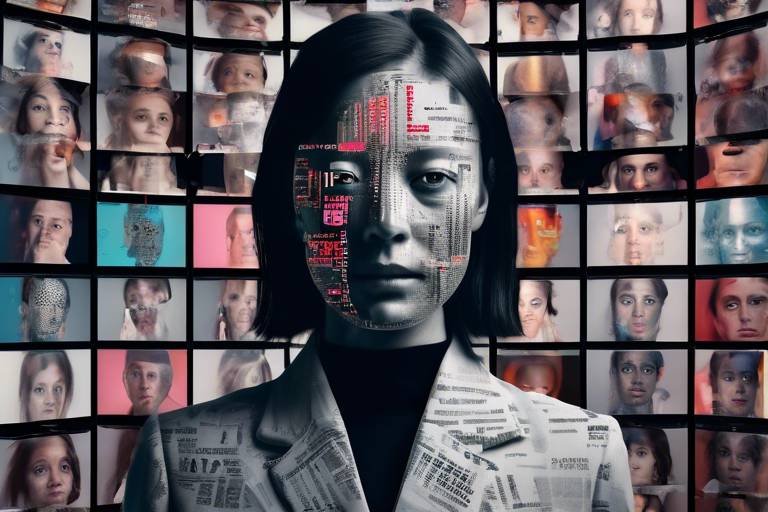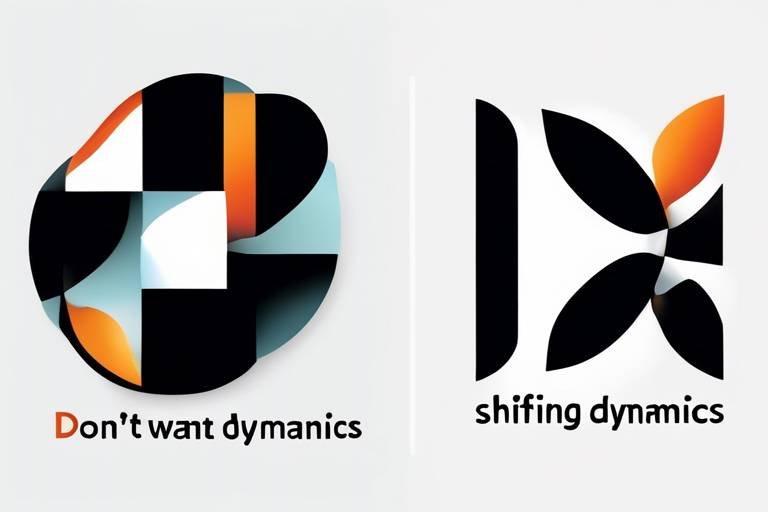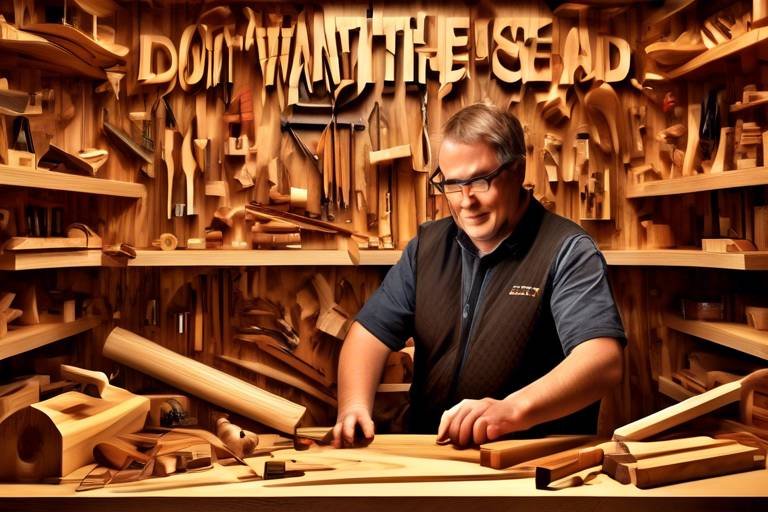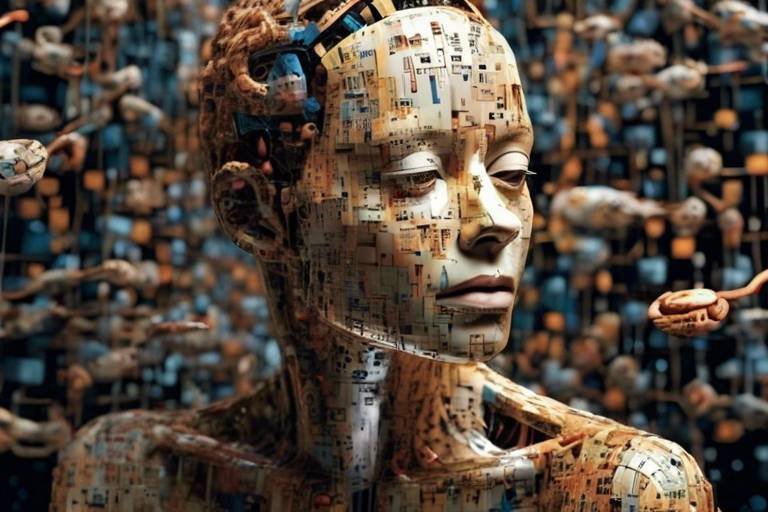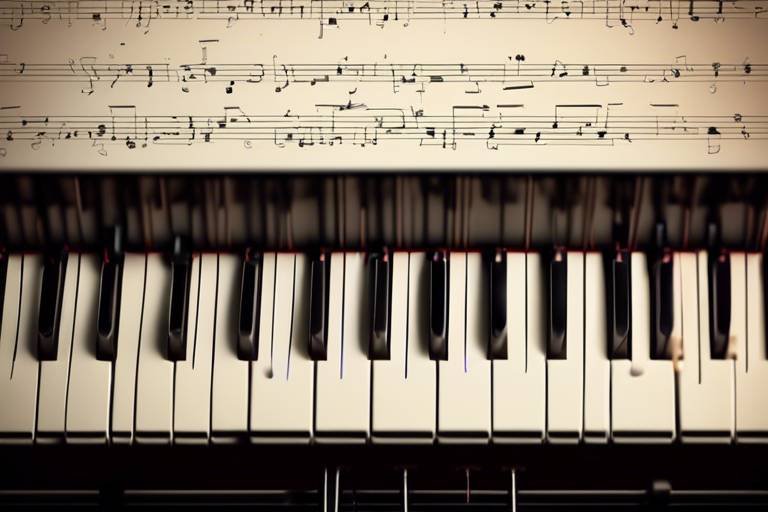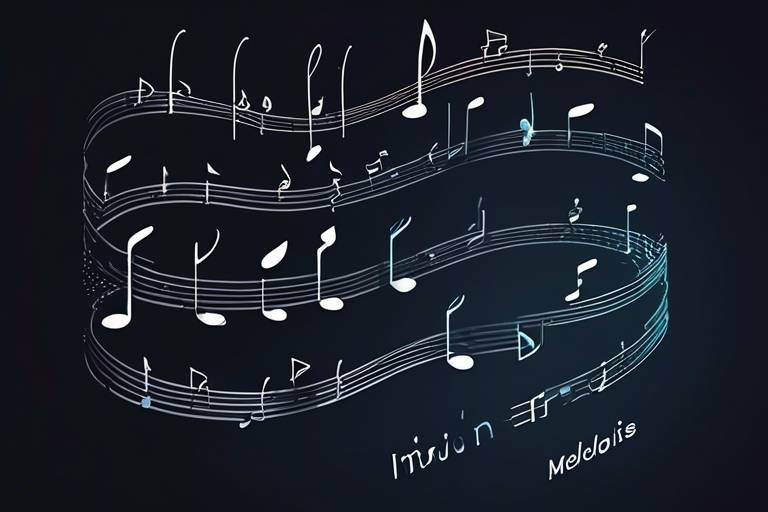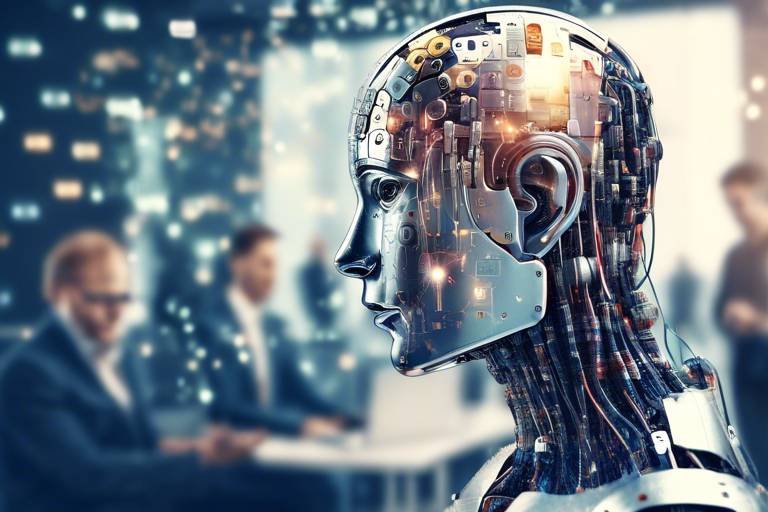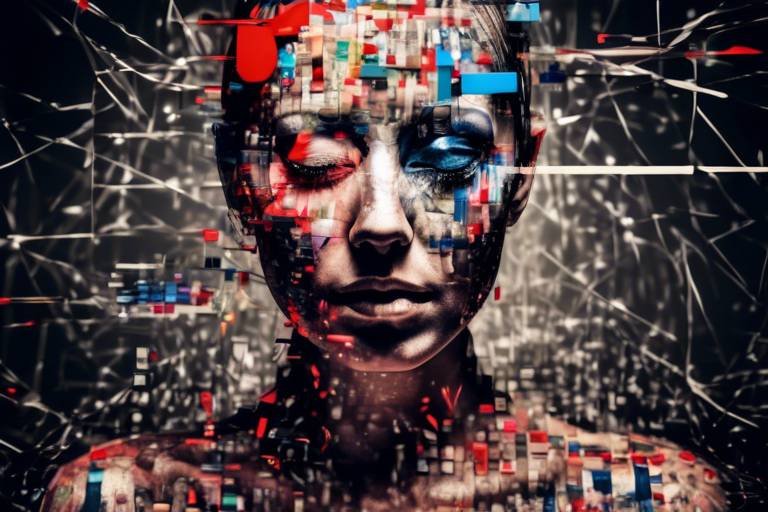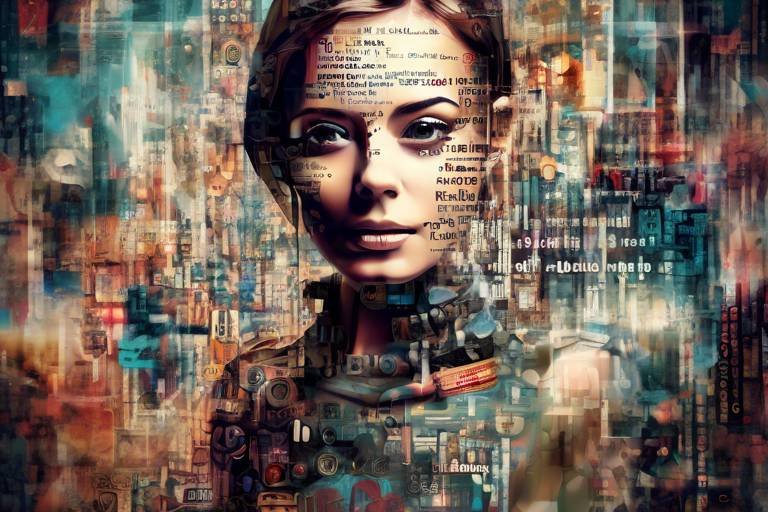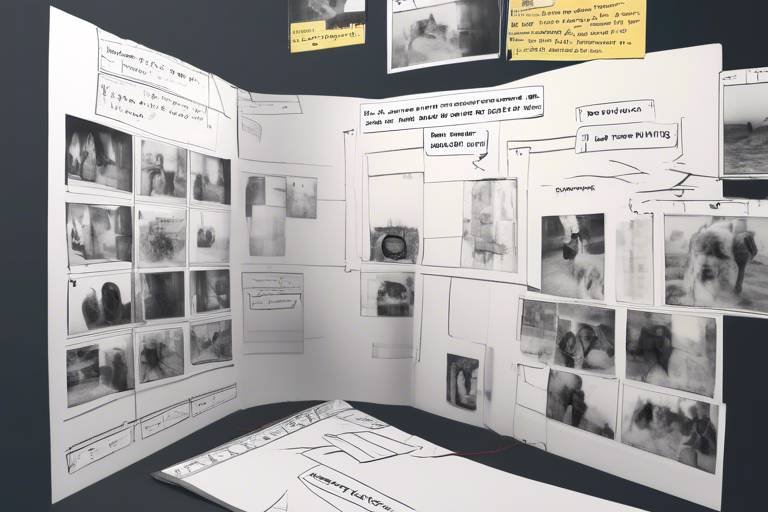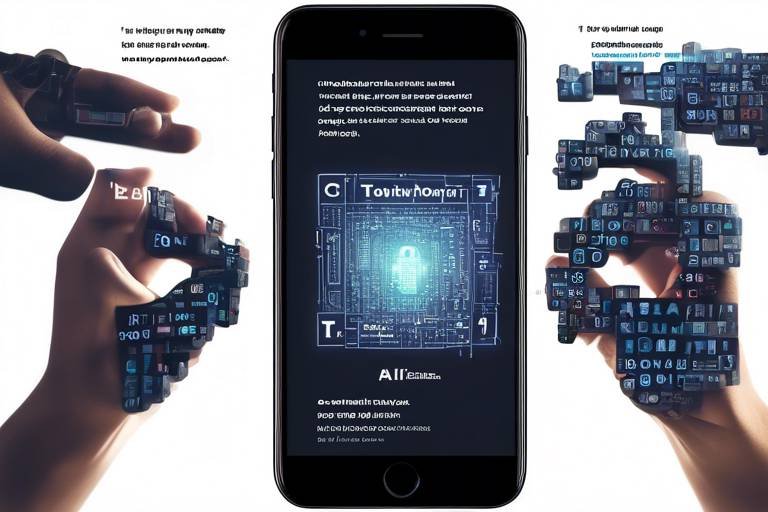Unveiling the AI Influence on New Media Art
The world of art is constantly evolving, and with the advent of artificial intelligence, we are witnessing a profound transformation in new media art. This innovative intersection of technology and creativity is not just a passing trend; it’s a revolution that is reshaping how artists create, how audiences engage, and how art is critiqued. Imagine a canvas that can think, adapt, and even surprise you with its creations—this is the essence of AI in new media art. As we delve deeper into this topic, we will explore the implications of AI on creativity, production, and the overall artistic experience.
New media art, which includes digital art, video art, and interactive installations, has always been at the forefront of technological advancements. From the early days of computer graphics to the integration of virtual reality, artists have continuously embraced new tools to expand their creative horizons. Now, with AI, artists are not just using technology as a medium; they are collaborating with it. This partnership opens up a world of possibilities, allowing for the generation of unique ideas and artworks that challenge our traditional perceptions of creativity.
As we navigate through the realms of AI's influence, it’s crucial to consider both the exhilarating opportunities and the daunting challenges it presents. On one hand, AI acts as a creative partner, pushing the boundaries of what we thought was possible in art. On the other hand, it raises ethical questions about authorship, originality, and the role of the artist. How do we define an artwork created by a machine? Who owns the rights to an AI-generated piece? These are just some of the questions we will explore as we unravel the intricate relationship between artificial intelligence and new media art.
In the following sections, we will delve into the evolution of new media art, the role of AI as a collaborator, and its impact on art criticism and market trends. From generative art and interactive installations to AI-powered analysis tools, the influence of AI is pervasive and transformative. So, buckle up as we embark on this fascinating journey into the heart of AI's influence on contemporary artistic practices!
New media art has undergone significant changes over the years, driven by technological advancements. This section delves into its history and how it has adapted to incorporate AI technologies.
Artificial intelligence is increasingly seen as a collaborator in the creative process. This section discusses how artists are utilizing AI to generate new ideas and enhance their artistic expression.
Generative art relies on algorithms to create unique pieces. Here, we explore how AI algorithms are shaping the aesthetics of new media art and pushing the boundaries of creativity.
This subsection highlights notable generative artists who successfully integrate AI into their work, showcasing their innovative approaches and the resulting artworks.
The use of AI in art raises important ethical questions. This part examines the challenges artists face, including copyright issues and the implications of machine-generated content.
Interactive installations are revolutionizing audience engagement. This section discusses how AI enhances interactivity in new media art, creating immersive experiences for viewers.
AI is not only influencing creation but also art criticism. This section investigates how AI tools are being employed to analyze and critique new media art.
AI-powered tools are transforming the way art is analyzed. Here, we explore various technologies that assist critics and curators in understanding and interpreting artworks.
AI's influence extends to the art market. This subsection discusses how AI is shaping trends in art sales, valuation, and collecting practices in the new media landscape.
- What is new media art? New media art refers to art forms that incorporate new technologies, including digital art, video art, and interactive installations.
- How does AI influence creativity in art? AI acts as a collaborator, helping artists generate new ideas and explore innovative techniques that push creative boundaries.
- What are the ethical concerns regarding AI in art? Key concerns include authorship, copyright issues, and the implications of machine-generated content.
- Can AI create art independently? While AI can generate art, the debate continues about whether such creations can be considered original or authentic.
- How is AI changing the art market? AI is influencing art sales, valuations, and collecting practices, leading to new trends in the market.

The Evolution of New Media Art
New media art has been on a thrilling ride since its inception, evolving in tandem with technological advancements that have reshaped our world. In the early days, artists experimented with video, sound, and interactivity, laying the groundwork for what we now recognize as new media art. It's fascinating to think about how these pioneers were like explorers, charting unknown territories in the vast ocean of digital creativity. They embraced the unknown, blending traditional art forms with emerging technologies to create something entirely new.
As we moved into the 21st century, the evolution of new media art accelerated dramatically. The introduction of the internet revolutionized how art is created, shared, and experienced. Artists began to utilize online platforms to showcase their work, reaching global audiences in ways that were previously unimaginable. This shift was akin to opening a window to the world, allowing diverse voices and perspectives to enter the art scene. The democratization of art through digital means has empowered countless creators, making it possible for anyone with a computer and a vision to become an artist.
But the most significant leap in recent years has been the integration of artificial intelligence into the artistic process. AI technologies have not only provided new tools for creation but have also challenged our understanding of authorship and creativity itself. Imagine a world where a machine can generate artwork that rivals human creativity; it’s both exciting and a little unsettling, isn't it? This intersection of art and technology has sparked a vibrant dialogue about what it means to be an artist in the age of AI.
To illustrate this evolution, let’s take a look at some key milestones:
| Year | Milestone | Impact |
|---|---|---|
| 1960s | Emergence of Video Art | Introduced moving images as a legitimate art form. |
| 1980s | Interactive Installations | Engaged audiences in new ways, making them part of the artwork. |
| 2000s | Internet Art | Expanded access to art and allowed for global collaboration. |
| 2010s | Integration of AI | Revolutionized creative processes and raised questions about authorship. |
As we look to the future, it’s clear that new media art will continue to evolve, driven by technological innovations and the ever-changing landscape of society. The integration of AI is just the beginning; who knows what other groundbreaking technologies will emerge? The possibilities are as vast as the digital universe itself, and artists are at the forefront of this exploration. They are not just observers but active participants in shaping the narrative of how we perceive and interact with art.
In conclusion, the evolution of new media art is a testament to the resilience and adaptability of artists. They have embraced change, harnessed new technologies, and redefined what art can be. As we stand on the brink of further advancements, it’s essential to recognize that the journey is just as important as the destination. Each step forward opens up new avenues for creativity, collaboration, and expression, making the future of new media art an exciting frontier to watch.

AI as a Creative Partner
In the realm of artistic expression, the emergence of artificial intelligence has sparked a revolutionary shift in how creativity is perceived and executed. Gone are the days when artists solely relied on their intuition and traditional techniques. Today, AI has stepped into the spotlight, not just as a tool, but as a genuine creative partner. Imagine having a collaborator that can analyze countless data points, suggest innovative ideas, and even generate art forms that challenge human creativity. It’s like having a brainstorming buddy who never tires and always brings fresh perspectives!
Artists are increasingly embracing AI technologies to push the boundaries of their work. For instance, they are using machine learning algorithms to analyze existing artworks and generate new pieces that reflect unique styles or concepts. This collaboration between human creativity and machine intelligence allows for an exciting fusion of ideas, leading to the creation of pieces that might not have been possible otherwise. It's like mixing paint colors; sometimes, the unexpected combination results in a masterpiece that surprises even the creator!
One fascinating aspect of this partnership is the way artists interact with AI systems. They often provide initial concepts, and the AI refines these ideas, offering variations that the artist can then choose from. This process is akin to a conversation where both parties contribute to the final outcome. Artists can input parameters such as style, color, and form, and the AI generates a multitude of options. The artist then plays the role of a curator, selecting and refining the best outputs. This dynamic not only enhances the creative process but also allows artists to explore new avenues they may not have considered.
Moreover, the use of AI in art creation raises intriguing questions about authorship and originality. When an AI generates a piece of art, who is the true creator? Is it the artist who programmed the AI, or the AI itself? This ambiguity invites discussions about the nature of creativity and the role of technology in art. As artists navigate these waters, they are also finding ways to infuse their personal touch into AI-generated works, ensuring that the final product reflects their unique vision.
To illustrate the impact of AI as a creative partner, consider the following examples of how artists are utilizing this technology:
| Artist | AI Tool Used | Outcome |
|---|---|---|
| Refik Anadol | Machine Learning Algorithms | Stunning visual installations that blend data and art |
| Mario Klingemann | Neural Networks | Innovative generative art that explores the concept of machine creativity |
| Anna Ridler | Custom AI Models | Artworks that challenge perceptions of AI and human collaboration |
This table showcases just a few artists at the forefront of integrating AI into their creative processes. Their work exemplifies how AI can enhance artistic practices, providing tools that expand the possibilities of what art can be. As we continue to explore this exciting intersection of technology and creativity, it's clear that AI is not merely a fad; it's becoming an essential component of the artistic toolkit.
In conclusion, the partnership between artists and AI is reshaping the landscape of new media art. It’s a thrilling time for creativity, as artists leverage AI to unlock new realms of possibility. This collaboration not only enhances individual expression but also invites audiences to engage with art in novel ways. As we delve deeper into this synergy, we can only imagine the extraordinary creations that lie ahead.
- How does AI influence artistic creativity? AI acts as a collaborator, providing new ideas and enhancing the creative process.
- Can AI create original art? Yes, AI can generate unique pieces, but the question of authorship remains complex.
- What are some examples of AI in art? Artists like Refik Anadol and Mario Klingemann utilize AI to create innovative works.

Generative Art and Algorithms
Generative art is a fascinating intersection of creativity and technology, where algorithms serve as the brush and canvas for artists. Imagine a painter who, instead of wielding a brush, programs a computer to create stunning visual compositions. This is the essence of generative art, where the artist sets the rules and the machine generates the artwork. The beauty of this form of art lies in its unpredictability; each piece is unique, a product of the algorithm's execution and the parameters set by the artist.
At its core, generative art relies on mathematical algorithms and computer programming to produce visuals, sound, and even interactive experiences. Artists can manipulate variables, allowing for an infinite range of outcomes. For instance, an artist might create a program that generates a new piece of art each time it runs, leading to an endless variety of outcomes. This process not only challenges traditional notions of authorship but also invites viewers to engage with the art in a dynamic way.
One of the most exciting aspects of generative art is its ability to push the boundaries of creativity. Artists are no longer confined to their physical skills or materials; they can explore complex systems and chaotic patterns that would be impossible to replicate manually. For example, an artist might use algorithms to simulate natural processes, such as the growth of trees or the movement of clouds, resulting in visually stunning representations of nature that evoke a sense of wonder.
Moreover, generative art often incorporates machine learning, allowing algorithms to learn from data and evolve over time. This means that the more an artist works with a particular algorithm, the more refined and sophisticated the outputs can become. It's like training a pet; the more you engage with it, the better it understands your preferences and reacts accordingly. This evolving relationship between artist and algorithm opens up new avenues for artistic expression.
However, the integration of algorithms into art also raises some intriguing questions. For instance, who is the true creator of a generative artwork? Is it the artist who devised the algorithm, or the algorithm itself? This blurring of lines challenges our understanding of creativity and authorship in the digital age. As generative art continues to gain traction, it invites us to reconsider what it means to be an artist in an era where machines can collaborate in the creative process.
In summary, generative art and algorithms are transforming the artistic landscape, offering new tools and methods for creative expression. As artists embrace these technologies, they are not only expanding their creative horizons but also redefining the relationship between human and machine. The future of art is being written in code, and the possibilities are as limitless as the imagination itself.
- What is generative art? Generative art is a form of art that is created using algorithms and computer programming, allowing for unique and unpredictable outcomes.
- How does AI influence generative art? AI enhances generative art by enabling algorithms to learn from data, resulting in more sophisticated and evolving artistic outputs.
- Who is the creator of a generative artwork? The question of authorship is complex; it can be attributed to both the artist who creates the algorithm and the algorithm itself.
- Can generative art be interactive? Yes! Many generative artworks are designed to be interactive, allowing viewers to engage with the art in real-time.

Case Studies of Generative Artists
In the fascinating realm of generative art, several artists have emerged as pioneers, skillfully weaving artificial intelligence into the fabric of their creative processes. These artists are not just using AI as a tool; they are treating it as a collaborative partner, pushing the boundaries of what art can be. Let’s dive into some remarkable case studies that highlight their innovative approaches and the stunning artworks that result from this synergy.
One standout figure is Refik Anadol, whose work exemplifies the potential of AI in creating immersive visual experiences. Anadol’s projects often involve the analysis of vast datasets, transforming them into mesmerizing visualizations. For instance, his piece “Machine Hallucinations” utilizes a deep learning algorithm to interpret and visualize a collection of images from various sources, including architecture and nature. The result is a stunning, dreamlike landscape that challenges our perceptions of reality and art. Anadol’s work not only captivates the audience but also invites them to ponder the relationship between technology and human creativity.
Another notable artist is Mario Klingemann, who explores the intersection of AI, art, and culture. Klingemann is known for his generative art that often incorporates neural networks and machine learning. His project “Neural Glitch” showcases how AI can generate unique visual glitches, creating a dialogue between the algorithm and the artist. By feeding the AI with a variety of images and styles, Klingemann allows the machine to produce unexpected outcomes, resulting in artworks that challenge traditional artistic norms. His approach raises important questions about authorship and the role of the artist in the age of AI.
Then, we have Anna Ridler, who combines her background in data science with her passion for art. Ridler’s work often focuses on the concept of transparency in AI-generated art. In her project “Mosaic Virus”, she used a dataset of over 10,000 images of flowers to train a neural network. The resulting artworks not only reflect the beauty of nature but also highlight the underlying data and algorithms that contribute to their creation. Ridler’s work emphasizes the importance of understanding the technology behind generative art, making her a vital voice in the conversation about AI and creativity.
These artists exemplify how generative art can be a collaborative and dynamic process. By embracing AI as a partner in creation, they are not only producing visually stunning works but are also engaging in deeper conversations about the nature of art in a digital age. Their contributions challenge our preconceived notions of creativity and invite us to explore the possibilities that arise when human imagination meets artificial intelligence.
In conclusion, the case studies of Refik Anadol, Mario Klingemann, and Anna Ridler illustrate the profound impact of generative artists on the evolution of new media art. Their innovative practices showcase how AI can enhance artistic expression, leading to new forms of creativity that resonate with audiences in ways we are only beginning to understand.
- What is generative art? Generative art refers to art created using autonomous systems, often involving algorithms or AI to produce unique pieces.
- How do artists use AI in their work? Artists use AI to analyze data, generate new ideas, and create visualizations that might not be possible through traditional methods.
- Are there ethical concerns with AI-generated art? Yes, issues such as copyright, authorship, and the implications of machine-generated content raise important ethical questions.
- Can AI replace human artists? While AI can assist in the creative process, it is unlikely to replace the unique perspectives and emotional depth that human artists bring to their work.

Challenges and Ethical Considerations
As artificial intelligence continues to permeate the world of new media art, it brings with it a host of challenges and ethical considerations that artists, critics, and audiences must grapple with. One of the most pressing issues is the question of authorship. When an artwork is generated by an algorithm, who is the true creator? Is it the artist who designed the algorithm, the AI itself, or perhaps even the data that fed into the system? This dilemma can lead to significant disputes over copyright and ownership, as traditional definitions of authorship struggle to keep pace with technological advancements.
Moreover, the integration of AI in the creative process raises concerns about originality. With machines capable of analyzing vast amounts of data and generating content that mimics human creativity, there is a fear that art may become homogenized, leading to a loss of individual expression. Artists may find themselves competing against algorithms that can produce art at an unprecedented speed and scale, potentially diluting the value of human-made works. This phenomenon is akin to a chef being replaced by a cooking robot—while the robot may produce visually appealing dishes, it lacks the unique touch and emotional depth that comes from human experience.
Another significant challenge is the ethical use of data. AI systems learn from existing datasets, which often include works from various artists. If these datasets are not curated responsibly, they can perpetuate biases or infringe upon the rights of original creators. For instance, if an AI is trained on a dataset that contains uncredited works, it may generate new pieces that closely resemble those originals, raising the specter of plagiarism and intellectual property theft.
Furthermore, the question of transparency in AI processes cannot be overlooked. Many AI algorithms operate as "black boxes," making it difficult for artists and audiences to understand how decisions are made. This lack of transparency can lead to mistrust and skepticism about the authenticity of AI-generated art. Imagine walking into a gallery, admiring a piece, only to learn that its creation involved a complex algorithm that you cannot fully comprehend. The magic of art can feel diminished when the process is shrouded in mystery.
As we navigate these challenges, it is essential for the art community to engage in ongoing discussions about the implications of AI in art. Artists, technologists, and ethicists must collaborate to establish guidelines that respect the rights of creators while embracing the potential of AI as a tool for innovation. By fostering an environment of transparency and accountability, we can ensure that the integration of AI into new media art enriches rather than diminishes the creative landscape.
- What are the main ethical concerns regarding AI in art?
The main concerns include authorship, originality, data usage, and transparency in AI processes.
- How does AI impact the value of human-made art?
AI's ability to produce art quickly may lead to a perception that human-made art is less valuable, potentially diluting individual expression.
- Can AI-generated art be copyrighted?
This is a complex issue, as it depends on the jurisdiction and the specific circumstances of creation. Generally, copyright laws are still adapting to address AI-generated works.

Interactive Installations and AI
When you think of art, what comes to mind? A static painting hanging on a wall, perhaps? Well, the landscape of art is shifting dramatically, thanks to the integration of artificial intelligence into interactive installations. These installations are not just about observing; they invite the audience to engage, to interact, and to become part of the artistic experience. Imagine walking into a gallery where the artwork responds to your movements, emotions, or even the sound of your voice. This is the magic of AI-enhanced interactive installations!
At the heart of these experiences lies the ability of AI to process data in real-time, creating a dynamic relationship between the viewer and the artwork. For instance, an installation might use facial recognition technology to gauge the viewer's mood and adjust its visuals accordingly. This kind of interaction transforms the passive act of viewing into an active dialogue, making each encounter unique and personal. It’s like having a conversation with the art itself!
Artists are harnessing AI to push boundaries and explore new dimensions of creativity. One fascinating example is the use of machine learning algorithms that adapt the installation based on audience interactions. This leads to a constantly evolving piece of art that can change from one moment to the next, reflecting the collective experience of those who engage with it. In this way, the installation becomes a mirror, reflecting the emotions and reactions of its audience.
Here’s a quick rundown of how AI is revolutionizing interactive installations:
- Real-Time Interaction: AI enables artworks to respond instantly to viewer actions.
- Personalization: Each viewer's experience can be tailored based on their interactions.
- Data Utilization: Artists can analyze how audiences engage with their work, providing insights into human behavior.
However, the integration of AI into interactive installations is not without its challenges. Artists must navigate technical limitations, ensuring that the technology enhances rather than detracts from the artistic vision. Moreover, there are ethical considerations regarding data privacy and the implications of using personal data to shape artistic experiences. As the art world embraces these new technologies, it must also grapple with the responsibilities that come with them.
In conclusion, AI is not just a tool for creating art; it is a catalyst for a new form of artistic expression that invites viewers to step into the artwork and become part of the narrative. Interactive installations powered by AI are redefining the relationship between art and audience, making art more accessible and engaging than ever before. As we move forward, it will be exciting to see how artists continue to innovate and explore the possibilities that AI brings to the table.
- What is an interactive installation? An interactive installation is a type of artwork that requires audience participation, allowing viewers to engage with the piece in a dynamic way.
- How does AI enhance interactive installations? AI enhances interactive installations by enabling real-time responses to audience actions, creating a personalized and immersive experience.
- What are the ethical considerations of using AI in art? Ethical considerations include data privacy, the implications of machine-generated content, and the responsibilities of artists in using personal data.

The Role of AI in Art Criticism
As we dive deeper into the world of art criticism, it's fascinating to see how artificial intelligence is reshaping this field. Traditionally, art criticism has relied heavily on human interpretation, subjective opinions, and cultural context. However, with the advent of AI, a new layer of analysis is emerging that complements human insights and offers fresh perspectives. So, how exactly is AI making waves in art criticism?
One of the most significant changes brought about by AI is its ability to analyze vast amounts of data quickly and accurately. Imagine a critic who can sift through thousands of artworks, exhibition reviews, and historical references in mere seconds! AI-powered tools are equipped to do just that, providing critics and curators with invaluable insights that were previously unimaginable. These tools can identify patterns, trends, and even emotional responses within artworks, giving critics a broader context in which to place their evaluations.
For instance, AI can analyze the color palettes, composition styles, and subject matter of various artworks to generate data-driven insights. This is not just about crunching numbers; it’s about enhancing the understanding of how different elements within an artwork resonate with audiences. By leveraging machine learning algorithms, critics can uncover correlations between artistic styles and viewer reactions, leading to a more nuanced appreciation of art.
Moreover, AI is also revolutionizing the way we approach art valuation. In the past, determining an artwork's worth was often subjective, reliant on the opinions of a few experts. Now, AI tools can analyze market trends, past sales data, and even social media buzz to provide a more objective valuation. This shift is not just beneficial for collectors but also for artists, as it allows them to understand how their work is perceived in the market.
However, the integration of AI into art criticism is not without its challenges. Critics must grapple with the question of authenticity. Can an AI truly understand the emotional weight and cultural significance of an artwork? While AI can analyze data and trends, it lacks the human experience and emotional intelligence that often inform a critic's perspective. This raises intriguing questions about the future of art criticism: Will AI become a trusted ally, or will it remain a tool that complements human insight?
As we look ahead, it is clear that the role of AI in art criticism will continue to evolve. Critics who embrace AI tools can enhance their analyses and offer more comprehensive critiques. However, it is essential to strike a balance between data-driven insights and the irreplaceable human touch that brings depth to art criticism. After all, art is not just about numbers; it's about the stories, emotions, and connections that resonate with us on a personal level.
- What are AI-powered art analysis tools? These are technologies that utilize algorithms to analyze various aspects of artworks, including style, composition, and audience reactions.
- How does AI influence art valuation? AI can analyze market trends and past sales data to provide more objective valuations of artworks, helping artists and collectors make informed decisions.
- Can AI replace human art critics? While AI can enhance the analysis process, it cannot fully replace the emotional intelligence and subjective insights that human critics provide.
- What are the ethical considerations of using AI in art criticism? There are concerns about authenticity, the potential for bias in AI algorithms, and the implications of relying on machine-generated insights over human interpretation.

AI-Powered Art Analysis Tools
In the dynamic realm of art, the introduction of is nothing short of revolutionary. These sophisticated technologies are reshaping how critics, curators, and even artists themselves engage with artworks. Imagine having a digital assistant that can analyze the nuances of a painting or sculpture, not just in terms of aesthetics but also its emotional impact and historical context. This is precisely what AI tools are designed to do, and they are becoming essential in the toolkit of modern art professionals.
One of the most exciting aspects of these tools is their ability to process vast amounts of data quickly. For instance, algorithms can analyze thousands of paintings to identify patterns in color use, composition, and style, providing insights that would take a human critic much longer to uncover. This capability not only enhances the understanding of individual artworks but also contributes to broader trends within the art world. By examining how different artists have approached similar themes over time, AI can help critics draw connections that might otherwise go unnoticed.
Moreover, AI analysis tools can offer a level of objectivity that human critics sometimes struggle to maintain. Art is inherently subjective, influenced by personal taste and cultural background. However, AI can assess artworks based on quantifiable metrics, such as color harmony and symmetry, providing a more balanced perspective. This does not mean that the human touch is rendered obsolete; rather, it complements traditional analysis, allowing for a richer dialogue between human interpretation and machine learning.
To illustrate the impact of AI-powered tools, consider the following table that highlights some of the key functionalities these technologies offer:
| Tool Name | Functionality | Use Case |
|---|---|---|
| Artify | Style Recognition | Identifying artistic styles in paintings |
| DeepArt | Image Transformation | Transforming photos into artworks |
| ArtRank | Market Analysis | Analyzing art market trends and valuations |
| Artify.ai | Emotion Recognition | Assessing emotional responses to artworks |
As these tools evolve, they are also beginning to incorporate machine learning and natural language processing, allowing them to provide more nuanced critiques. For example, an AI could analyze written critiques and compare them against visual data, offering suggestions for improvement or highlighting overlooked elements in an artwork. This synergy between visual analysis and textual critique is paving the way for a new era of art appreciation and evaluation.
However, the rise of AI in art analysis is not without its challenges. Questions about authenticity and interpretation arise when machines begin to play an active role in critique. Are we at risk of losing the human element that makes art so profoundly impactful? While AI can offer valuable insights, it is crucial to remember that art is not just about data; it is also about emotion, context, and personal experience. Thus, the best approach may be one that combines the analytical prowess of AI with the empathetic understanding of human critics.
In conclusion, AI-powered art analysis tools are transforming the way we engage with art. They provide a unique blend of quantitative analysis and qualitative insights, enriching the art criticism landscape. As we continue to explore this intersection of technology and creativity, we can anticipate a future where AI not only assists in understanding art but also inspires new ways of creating it.
- What are AI-powered art analysis tools? These are technologies that utilize artificial intelligence to analyze and interpret artworks, providing insights into their aesthetics, emotional impact, and market trends.
- How do these tools enhance art criticism? They offer objective analysis based on quantifiable metrics, complementing human interpretation and allowing for a richer dialogue about artworks.
- Can AI replace human art critics? While AI can provide valuable insights, it cannot replace the emotional and contextual understanding that human critics bring to the table.
- What are some examples of AI art analysis tools? Examples include Artify, DeepArt, ArtRank, and Artify.ai, each offering unique functionalities for art analysis.

Impact on Art Market Trends
The art market is a dynamic ecosystem, constantly evolving with shifts in technology, culture, and consumer preferences. One of the most profound transformations in recent years has been the influence of artificial intelligence (AI) on art market trends. As AI continues to permeate various aspects of society, its impact on the art world cannot be overstated. The integration of AI technologies is reshaping how art is created, valued, and sold, creating exciting opportunities and challenges for artists, collectors, and investors alike.
First and foremost, AI has introduced a new paradigm in art valuation. Traditional methods of appraising art often rely on subjective opinions and historical precedents. However, AI-powered tools can analyze vast amounts of data, including market trends, artist popularity, and sales history, to provide more objective assessments of an artwork's value. This data-driven approach not only enhances transparency but also helps to democratize access to art investment opportunities. Collectors can now make informed decisions based on comprehensive analyses rather than relying solely on expert opinions.
Moreover, AI is changing the way artworks are marketed and sold. Online platforms powered by AI algorithms can tailor recommendations to potential buyers, enhancing the shopping experience. Imagine browsing an online gallery that suggests pieces based on your previous purchases or even your social media activity. This level of personalization not only increases engagement but also drives sales, as buyers feel more connected to the art they are considering. Consequently, artists and galleries are leveraging AI to reach wider audiences and create targeted marketing campaigns that resonate with specific demographics.
Additionally, the rise of AI-generated art is challenging traditional notions of authorship and originality. As artists experiment with algorithms to create unique pieces, the question arises: who owns the rights to art created by a machine? This dilemma has significant implications for the art market, as it blurs the lines between creator and creation. The emergence of AI-generated artworks has led to new categories in auctions and galleries, with collectors eager to own pieces that embody the synergy between human creativity and machine intelligence.
Furthermore, AI is influencing investment strategies in the art market. Investors are increasingly looking at AI-generated artworks as viable assets, given their potential for appreciation. This trend has sparked discussions about the future of art as an investment vehicle. Will AI art hold its value as more pieces flood the market? Or will it become a niche category, appealing primarily to tech-savvy collectors? The answers to these questions remain uncertain, but one thing is clear: AI is reshaping the landscape of art investment.
To illustrate the impact of AI on art market trends, consider the following table that highlights key areas of influence:
| Area of Influence | Impact |
|---|---|
| Valuation | Data-driven assessments provide transparency and democratize access to art investments. |
| Marketing | Personalized recommendations enhance buyer engagement and increase sales. |
| Authorship | Challenges traditional notions of ownership and originality in art. |
| Investment | AI-generated art is emerging as a new asset class, prompting discussions on value retention. |
In conclusion, the impact of AI on art market trends is profound and multi-faceted. It is creating a more transparent, personalized, and dynamic market that is appealing to a new generation of collectors and investors. As we continue to explore the intersection of art and technology, it will be fascinating to see how these trends evolve and what new opportunities will arise for artists and audiences alike.
- How is AI changing the way art is valued? AI tools analyze large datasets to provide objective valuations, enhancing transparency in the art market.
- What role does AI play in marketing art? AI enhances marketing strategies through personalized recommendations, improving buyer engagement and driving sales.
- Who owns AI-generated art? The ownership of AI-generated artworks raises questions about authorship and originality, challenging traditional norms in the art world.
- Is AI-generated art a good investment? While AI-generated art presents new investment opportunities, its long-term value retention remains to be seen.
Frequently Asked Questions
- What is new media art?
New media art refers to artistic works created with the use of new media technologies, including digital art, video installations, and interactive pieces. It is a constantly evolving field that embraces innovation and often challenges traditional forms of art.
- How has AI influenced new media art?
AI has transformed new media art by serving as a creative partner for artists. It allows for the generation of unique ideas, enhances artistic expression, and creates interactive experiences that engage audiences in unprecedented ways.
- What is generative art?
Generative art is a form of art that is created through algorithms and computational processes. Artists use AI algorithms to produce unique artworks, often resulting in pieces that are unpredictable and innovative, pushing the boundaries of traditional artistic practices.
- Are there ethical concerns with AI in art?
Yes, the integration of AI in art raises several ethical questions, including issues of copyright, authorship, and the implications of machine-generated content. Artists must navigate these challenges to ensure their work respects both legal and moral standards.
- How does AI enhance audience engagement in art installations?
AI enhances audience engagement by creating interactive installations that respond to viewers' actions or emotions. This interactivity fosters a deeper connection between the artwork and the audience, making the experience more immersive and personal.
- What role does AI play in art criticism?
AI plays a significant role in art criticism by providing tools that analyze and interpret artworks. These AI-powered tools can assist critics and curators in understanding the nuances of new media art, offering insights that may not be immediately apparent.
- How is AI affecting the art market?
AI is influencing the art market by shaping trends in art sales, valuation, and collecting practices. It helps collectors and investors make informed decisions, while also impacting the way artworks are appraised and marketed in the new media landscape.

